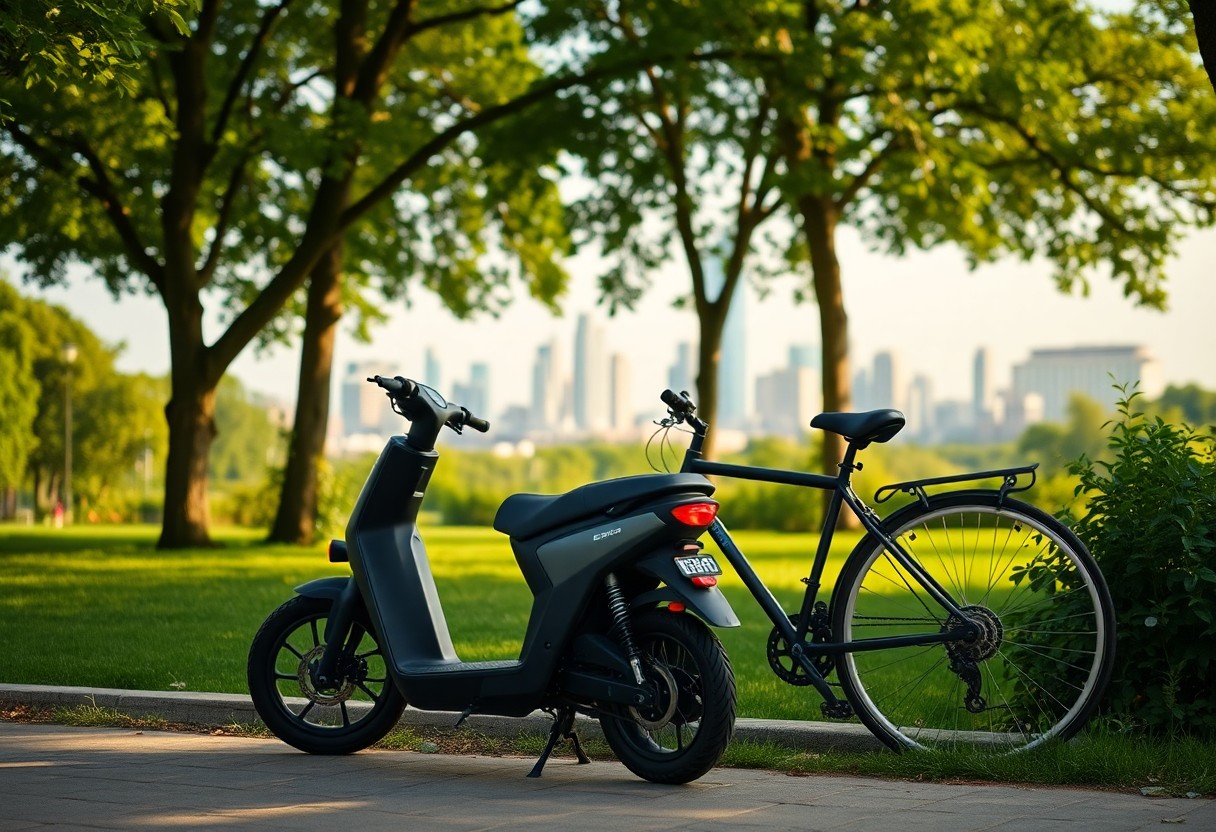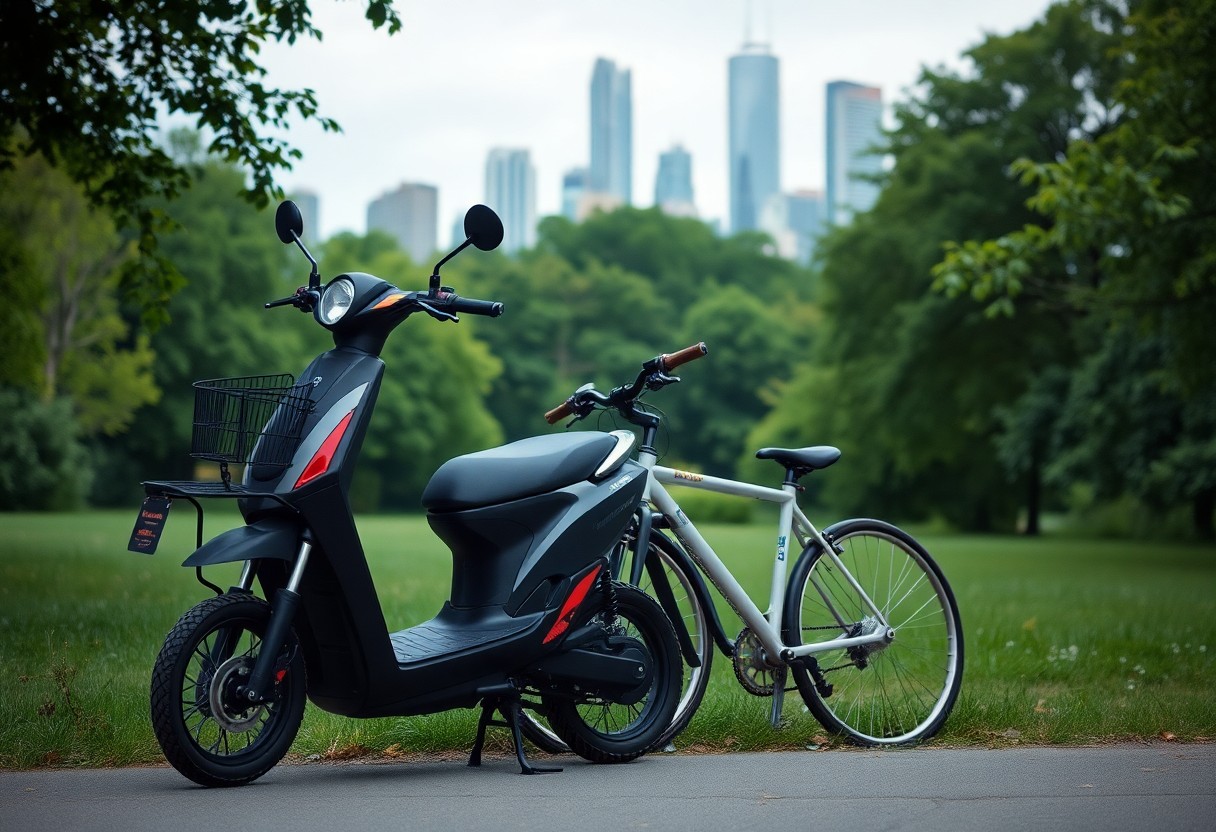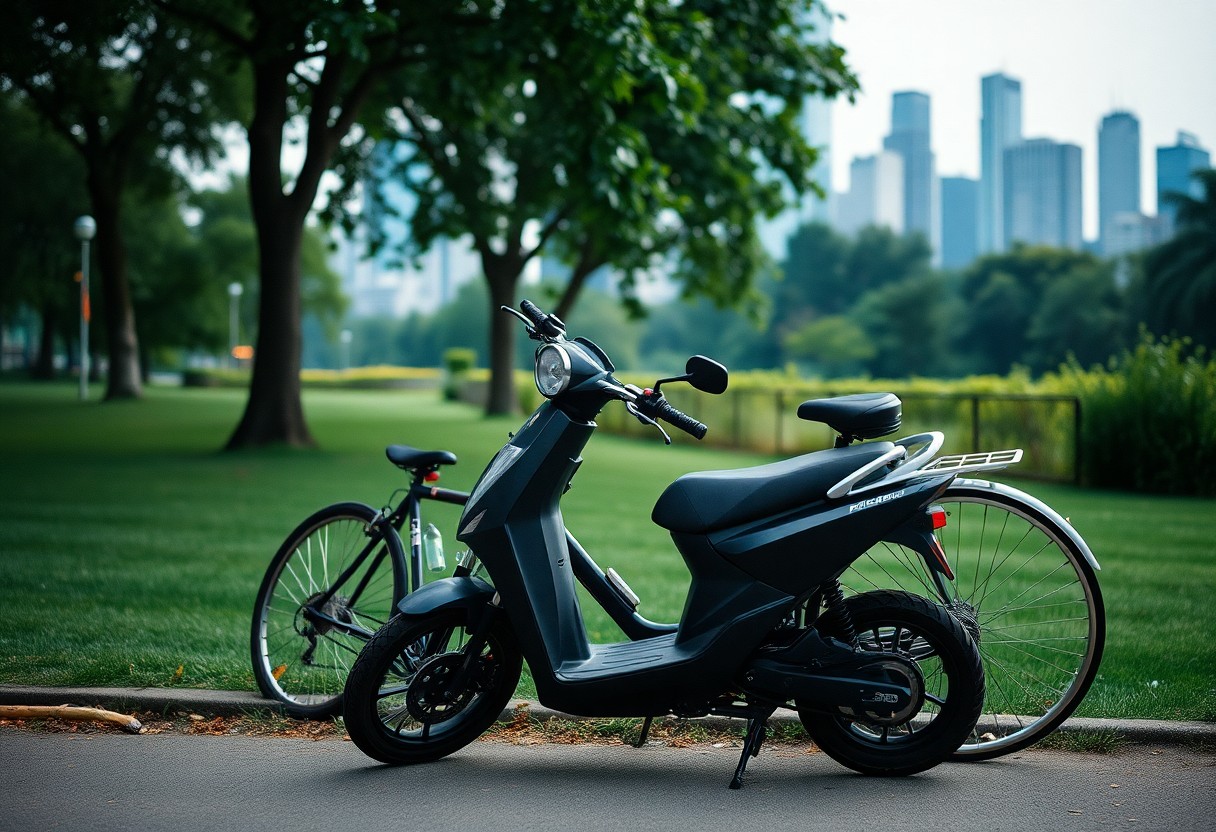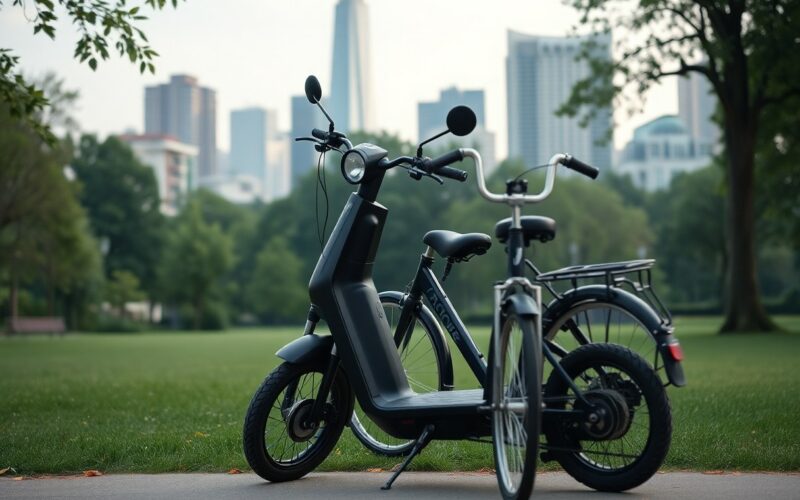With the rise of urban transportation options, you may be wondering whether electric scooters or traditional bicycles are more sustainable choices for your daily commute. As cities grapple with congestion and environmental impact, understanding the strengths and weaknesses of each mode can help you make informed decisions. By evaluating factors like energy consumption, manufacturing footprint, and lifetime emissions, you can assess which vehicle aligns better with your sustainability goals. In this post, we’ll explore the environmental implications of both options to guide your choice.
Table of Contents
Key Takeaways:
- Electric scooters generally have a lower upfront carbon footprint compared to traditional bicycles due to manufacturing processes and materials.
- Bicycles tend to have a longer lifespan and require less maintenance, making them more sustainable over time.
- Battery production and disposal for electric scooters raise environmental concerns, highlighting the importance of battery recycling and sustainable sourcing.
- Both options contribute to reduced urban congestion and lower emissions compared to cars, but the operational efficiency may vary based on usage patterns.
- Infrastructure availability and local regulations play significant roles in determining which mode of transport is more sustainable in specific areas.
Overview of Transportation Sustainability
For a better understanding of how your choices in transportation affect the environment, you need to explore the concept of sustainability in this field. Notably, sustainability in transportation refers to a balanced approach that meets the current transportation needs without compromising the ability of future generations to meet theirs. This involves not only reducing harmful emissions and resource consumption but also enhancing the overall efficiency and accessibility of transportation systems. By adopting more sustainable practices, you can make a significant difference in your carbon footprint and contribute positively to the planet.
Definition of Sustainability in Transportation
Transportation systems encompass various modes including automobiles, public transport, bicycles, and electric scooters. Each mode yields different environmental impacts. Effective sustainable transportation integrates methods that minimize negative impacts while promoting economic viability and social equity. This means reducing reliance on fossil fuels, enhancing energy efficiency, and fostering alternative, eco-friendly modalities that contribute to a cleaner environment.
Importance of Sustainable Transportation
After recognizing the definition, it becomes evident why sustainable transportation is important for your everyday decisions. As urban areas continue to expand, the reliance on conventional gasoline-powered vehicles leads to a significant increase in greenhouse gas emissions. By choosing sustainable options, you help combat air pollution, contribute to improved public health, and alleviate traffic congestion. Additionally, investing in sustainable transportation can lead to greater social equity by providing affordable mobility solutions for everyone.
Transportation choices directly impact your community’s ecological footprint. When you opt for bicycles or electric scooters over traditional vehicles, you are playing an active role in building a sustainable future. These choices not only reduce harmful emissions but also encourage a shift towards cleaner alternatives, promoting an eco-friendly mindset and enhancing urban mobility.
Key Metrics for Evaluating Sustainability
Definition of key metrics, such as *carbon footprint,* *energy consumption,* and *land usage,* provides insights into how your transportation choices impact the environment. For instance, by assessing the emissions produced by various transportation modes, you can gauge which options are more sustainable. By understanding these metrics, you begin to transparently evaluate the true cost of your commuting methods on the planet.
Evaluating sustainability in transportation requires you to consider multipronged aspects. These include how much energy is used per mile, the emissions produced, and the overall land resources consumed for infrastructure. By weighing these factors, you can make informed choices that align with sustainable practices and contribute to a cleaner, healthier environment.
To effectively gauge your transportation impact, it is necessary that you understand these metrics in context. When you consider not only emissions but also energy efficiency and land usage, you can better comprehend your contribution to sustainability. This holistic approach allows you to make choices that prioritize not just convenience but also the well-being of the planet.
Electric Scooters
One of the most significant innovations in urban transportation has been the rise of electric scooters. As you consider the environmental impact and sustainability of transportation options, e-scooters stand out as a convenient alternative to traditional bicycles. According to a study on Are E-Scooters Better Than E-Bikes for Commuting?, you may find significant benefits, particularly in urban settings where traffic congestion is a common issue.
Mechanism of Operation
Below the surface of e-scooters lies an efficient mechanism that incorporates a battery-powered motor, allowing you to travel short distances with ease. These scooters are typically equipped with electric motors ranging from 250 to 500 watts, which provide sufficient power for zipping through crowded city streets. The batteries are usually lithium-ion, known for their lightweight design and relatively fast charging times, making it easy for you to recharge your scooter between rides.
Additionally, the controls are straightforward, allowing you to accelerate using a throttle and decelerate with a brake. This simplicity means you don’t need extensive training to use them effectively, making e-scooters accessible to a broader audience. However, as a new user, it’s imperative for you to understand the local regulations regarding their use, including speed limits, designated paths, and safety gear requirements.
Environmental Impact
Before plunging into the environmental implications of using electric scooters, it’s vital to recognize their lower carbon footprint compared to gas-powered vehicles. E-scooters produce zero tailpipe emissions, which is a significant advantage in urban environments plagued by pollution. When considering the lifecycle of these scooters, including production and disposal, their impact can further be measured against traditional forms of transport.
Moreover, the electricity used to charge e-scooters can often come from renewable energy sources, thereby reducing your overall reliance on fossil fuels. However, the environmental cost of battery production must also be factored in, as lithium mining has its downsides, including ecosystem disruption and water use. Your choice of energy sources can make a big difference in the sustainability of e-scooters.
Consequently, the sustainability of e-scooters is a balancing act. While they offer significant immediate benefits, such as reduced emissions and convenience, the long-term implications of battery production and disposal can diminish their overall positive impact. Being aware of how often you use these scooters and considering alternatives such as bicycles for shorter trips can help mitigate their environmental footprint.
Social Implications
At the social level, electric scooters have changed the dynamics of urban transportation. They’ve provided a *new and exciting way for individuals to navigate city centers*, allowing you to travel short distances without the hassle of parking or traffic jams. Their popularity has led to the rise of scooter-sharing services, which can foster a *sense of community and accessibility*. However, the rise of e-scooters is not without challenges, including sidewalk congestion and safety concerns among pedestrians.
Additionally, you may encounter public resistance to e-scooters, often stemming from fears about accidents or improper parking. Effectively communicating and adhering to local traffic regulations can help alleviate these concerns, ensuring that e-scooters become more integrated into the fabric of urban mobility. Awareness and cooperation among users, pedestrians, and local authorities are important to maximize the societal benefits of this innovative mode of transport.
Understanding the social implications of electric scooters also involves looking at how they can provide affordable transportation options for residents in urban areas. You may find that e-scooters help reduce transportation inequality by offering an alternative means of travel for those who cannot afford personal vehicles. Balancing these social benefits with public safety and effective regulation can optimize their role in the urban landscape.

Bicycles
After considering the various aspects of electric scooters, it’s important to probe into the world of bicycles. These two-wheeled vehicles have been around for centuries and provide an excellent alternative for transportation while promoting sustainability. When you think about the full lifecycle of a bicycle, it’s clear how it can have a positive effect on the environment, society, and even your health.
Mechanism of Operation
Behind the simplicity of a bicycle lies an engineering marvel that showcases the effectiveness of human-powered transportation. A bicycle typically consists of fewer moving parts than an electric scooter, which means less wear and tear and ultimately less maintenance. The basic mechanism operates through pedaling, where your effort is converted into motion via a chain that drives the bike’s wheels. This efficient system allows you to cover significant distances without contributing to air pollution or consuming fossil fuels, making it a sustainable transport choice.
The design of bicycles also emphasizes lightweight materials, further enhancing their operational efficiency. Unlike electric scooters that rely on batteries and electric motors, bicycles depend entirely on your physical strength, requiring no electricity for locomotion. This simplicity not only reduces dependency on non-renewable energy sources but also makes bicycles an affordable transportation option for many.
Environmental Impact
On the environmental front, bicycles present a significantly lower carbon footprint when compared to electric scooters. By opting for a bicycle, you’re actively reducing the release of greenhouse gases into the atmosphere. The production of bicycles involves much less energy and fewer resources than that of electric scooters, which are often made with various metals and lithium-ion batteries. Every time you choose to pedal instead of driving or using electric scooters, you are contributing to a cleaner environment.
Indeed, the lifespan of a bicycle can far exceed that of an electric scooter, as they can last for many years with proper maintenance. This longevity means that fewer bicycles need to be produced over time, leading to decreased waste in landfills. Furthermore, since bicycles don’t require electricity or fuel to operate, they contribute to a substantial reduction in air pollution. As they are silent vehicles, bicycles do not add to noise pollution, which can drastically enhance the quality of urban life.
Social Implications
Across communities, bicycles foster a sense of connectivity and belonging. They are accessible to various demographics, whether you are a student, a working professional, or a retiree. This inclusivity encourages social interactions as you ride alongside fellow cyclists, enhancing community relations and promoting a healthier lifestyle. Riding a bicycle also encourages physical activity, contributing to better mental and physical health outcomes. The more you engage with your surroundings while biking, the more you contribute to vibrant, active communities.
And, bicycles can help reduce traffic congestion in urban areas, allowing for smoother commuting experiences for everyone. With increased bike lanes and infrastructure supporting cyclists, cities are becoming more accommodating to this eco-friendly mode of transportation. This shift not only benefits the community’s environment but also encourages a cultural shift towards sustainability and active living.

Comparative Analysis
Not all modes of personal transport are created equal when it comes to sustainability. To help you understand the differences between electric scooters and bicycles, we present a comparative analysis focusing on lifecycle assessment, carbon footprint, and cost comparison.
Lifecycle Assessment
Any assessment of sustainability must consider the entire lifecycle of a product, including manufacturing, usage, and disposal. In this case, both electric scooters and bicycles have unique impacts throughout their lifespans. Let’s break it down further:
Lifespan Considerations
| Electric Scooters | Usually last 1-3 years, primarily due to battery degradation. |
| Bicycles | Can last 10 years or more with proper maintenance and repair. |
This indicates that bicycles may have a lower overall environmental impact due to their durability and longer lifespan. Moreover, the materials used in manufacturing and the energy required for production also play a significant role in determining sustainability.
Carbon Footprint Comparison
Behind the physical differences lies the question of emissions. Electric scooters, while eco-friendly in their operation, often rely on partially renewable energy sources for charging. In contrast, bicycles operate completely emission-free. Here’s a summary of their carbon emissions:
Carbon Emission Metrics
| Electric Scooters | Approx. 50g CO2/km (considering indirect emissions). |
| Bicycles | 0g CO2/km. |
Additionally, the overall carbon footprint of manufacturing electric scooters is generally higher than that of bicycles, mainly due to the lithium-ion batteries they use. As a result, while using electric scooters can reduce congestion in urban areas, the initial carbon footprint associated with their production offsets some of the environmental benefits.
Additional Carbon Footprint Info
| Energy Source | Electric Scooters can vary based on the energy grid; some regions rely more on fossil fuels. |
| Usage Frequency | Higher usage can lead to lower average emissions per kilometer traveled. |
Cost Comparison
Along with environmental considerations, financial implications also matter when deciding between electric scooters and bicycles. The initial purchase price, maintenance, and running costs affect your long-term investment. Below is a cost comparison for both options:
Cost Analysis
| Electric Scooters | Purchase price: $300-$1,500; Maintenance cost: higher due to battery replacement. |
| Bicycles | Purchase price: $200-$1,000; Maintenance cost: typically lower. |
Over time, bicycles often prove to be the more economical choice, especially in urban settings where travel distances are shorter. Additionally, the ongoing costs of maintaining a bicycle are generally less than those of an electric scooter, making it a cost-effective option for everyday use.
Further Cost Insights
| Insurance | Electric Scooters may require insurance, adding to yearly costs. |
| Parking | Bicycles are usually less restricted in terms of parking options. |
Consequently, while electric scooters offer ease of use and convenience, the long-term costs and sustainability challenges may sway you towards choosing a bicycle as a more sustainable mode of transport. Understanding both environmental and financial implications is vital in making an informed decision that aligns with your values.

Urban Infrastructure and Policy Implications
Once again, the debate surrounding the sustainability of electric scooters and bicycles extends beyond individual preferences and environmental impacts to a broader conversation about urban infrastructure and policy implications. For cities attempting to promote sustainable transportation, effective integration of these modes into existing frameworks is necessary. This integration not only needs to accommodate the vehicles themselves but also create a seamless network that encourages their use. You may find that the success of either mode relies heavily on how well city planners align these options with public transport systems and urban development.
Integration into Public Transport Systems
With the rise of electric scooters, urban planners face the challenge of ensuring that these vehicles complement rather than compete with existing public transport systems. You might envision a city where, in a single trip, you can easily switch from your local train or bus to an electric scooter to reach your final destination. This requires dedicated infrastructure such as scooter parking zones near transit hubs and coordinated payment systems, aiming for an interconnected experience that encourages a shift away from car dependency.
Moreover, facilitating this integration can lead to increased ridership across all transport modes. As you consider the implications, curating a user-friendly environment where electric scooters and bicycles can thrive alongside public transport helps foster a community culture of sustainable choices. You may find it beneficial to push for policies that advocate for this integrated approach, understanding how vital it is to view all aspects of urban mobility as interrelated.
Policy Challenges for Electric Scooters
Across various cities, the rapid proliferation of electric scooters has ignited a range of policy challenges. These include issues of regulation, safety, and public space management. As you navigate these topics, consider that local governments must grapple with determining where scooters can operate, how they should be parked, and what measures are necessary to promote user safety on the roads. The lack of a regulatory framework can lead to cluttered sidewalks, increased pedestrian hazards, and concerns over the safety of riders themselves.
Due to the low barrier to entry associated with electric scooter rentals, attracting a mixed-use audience—both experienced and novice riders—can result in chaotic scenarios on the streets. You need to pay attention to how these vehicles are used and the potential impact on urban design. Balancing convenience with safety becomes imperative as cities address these challenges, demonstrating the importance of sensible regulation that protects both riders and pedestrians alike.
Promotion of Bicycle Infrastructure
About bicycles, the need for dedicated infrastructure has long been a hallmark of sustainable urban design. As you consider their role, think about how expanding bicycle lanes, promoting bike-sharing programs, and constructing secure parking facilities can fundamentally change the landscape of urban mobility. Such measures empower you and other residents to opt for cycling as a primary transportation mode by ensuring safety and accessibility, thus contributing to lower carbon emissions and less congested streets.
Your support for initiatives promoting bicycle usage could also foster a cultural shift towards sustainable transportation practices. As cities invest in dedicated bike paths and safe storage solutions, you may find that more people are encouraged to make the switch from car travel to biking. For instance, cities like Amsterdam have demonstrated that a robust cycling infrastructure can lead to high levels of bicycle use, ultimately reshaping urban transport paradigm.
Case Studies
Now, as you explore the sustainability of electric scooters and bicycles, it’s vital to analyze real-world case studies that highlight their impact. Here’s a detailed list of case studies that showcase the environmental implications of both modes of transport:
- San Francisco’s E-Scooter Pilot Program – During its initial six-month pilot, 6,000 e-scooters were deployed. The program reported 15,000 weekly rides, reducing emissions by an estimated 3,900 kg of CO2.
- Paris Bike-Sharing Scheme – The capital city of France boasts an impressive bike-sharing model with over 20,000 bicycles. In a recent year, the program achieved 5 million rides, leading to a 14% drop in car usage in certain urban areas.
- Mexico City’s E-Scooters – In 2022, e-scooters accounted for 45% of short-distance urban trips, significantly raising the share of sustainable transport in the city.
- Seattle’s Bicycle Infrastructure – Seattle has invested over $100 million in bike lanes. As a result, the use of bicycles jumped from 2% to 8% of total trips over five years, contributing to lower overall traffic congestion.
- Copenhagen’s Bicycles – In a city known for its cycling culture, 62% of residents commute by bike daily. This translates to an annual reduction of around 90,000 tons of CO2 emissions.
For a comprehensive analysis of the environmental impact of both scooters and bicycles, check out this insightful article on E-Scooters vs Electric Bicycles and Public Transportation: A.
Successful Implementations of Scooters in Cities
Between the rapid rise of e-scooters, several cities have successfully integrated these vehicles into their urban transportation frameworks. For instance, in Los Angeles, officials implemented strict regulations on e-scooter usage to promote safety while encouraging their adoption. The city reported that e-scooter trips replaced 25% of car rides within the first year of the program. Furthermore, the scooters provided a low-emission alternative, contributing to a 6% reduction in urban greenhouse gas emissions.
In Austin, e-scooters accounted for an impressive 66% of all short-distance rides in just two years, illustrating how effective policies and public acceptance can collaborate to build a more sustainable transport ecosystem. The use of geofencing and designated scooter zones has ensured that you can navigate the city with a lower risk of congestion and accidents.
Successful Bicycle Programs Globally
Successful bike-sharing programs around the globe have paved the way for increased urban sustainability. The city of Barcelona implemented a bike-sharing service with over 6,000 bikes, resulting in a staggering 20% increase in cycling for commuting purposes. This initiative has played a significant role in decreasing vehicle emissions and pollution levels in urban centers.
Successful bicycle initiatives have proven to be effective in creating a more interconnected and environmentally friendly transportation network. For example, in Amsterdam, where nearly 50% of all trips are taken using bicycles, the city has seen a sustained commitment to enhancing cycling infrastructure, leading to better air quality and healthier communities.
The integration of public bicycles into local transport systems not only promotes sustainability, but it enhances your mobility options. Prominent cities worldwide are now recognizing bicycles as a vital component of urban transport, thereby reducing reliance on fossil fuel-based vehicles.
Lessons Learned from Integrated Approaches
The experiences of cities combining bicycles and e-scooters into their transportation systems highlight the importance of integrated planning. For example, Berlin adopted measures to ensure that both forms of micromobility work harmoniously. With bike lanes accommodating e-scooter traffic, the city successfully lowered both congestion and emissions, demonstrating that collaboration is key to a successful transport strategy.
Moreover, cities that have integrated bike and e-scooter infrastructure have found that public awareness campaigns are vital for educating citizens about the benefits of these modes. In many cases, cities that actively engaged their residents with targeted outreach saw a greater acceptance and overall increase in usage.
At the core of lessons learned is the necessity to foster an environment that supports sustainable transport and educates citizens on the advantages of both bikes and e-scooters. Cities that prioritize safety, infrastructure, and public engagement are paving the way for a future where sustainable urban transport is the norm rather than an exception.
Conclusion
Drawing together the information on electric scooters and bicycles, it is clear that both options present viable alternatives to traditional modes of transportation. When you consider your lifestyle and daily commuting needs, you may find that bicycles offer a more sustainable choice due to their energy efficiency, lower environmental impact during production, and the health benefits they provide. Conversely, if you prioritize convenience and speed for shorter trips, electric scooters can be a strong contender, particularly in urban settings where traffic congestion is a concern. Ultimately, your choice will depend on how you plan to integrate these modes of transportation into your daily routine.
As you weigh the sustainability of electric scooters versus bicycles, it’s vital to consider factors such as energy consumption, maintenance, and the broader implications of manufacturing and waste. Both options contribute to reducing reliance on fossil fuels and minimizing your carbon footprint. By understanding the strengths and weaknesses of each, you can make an informed decision that aligns with your environmental values and transportation needs. Choose wisely, and you’ll not only enhance your mobility but also contribute positively to the sustainability of your community.
FAQ: Electric Scooters vs. Bicycles – Which Is More Sustainable?
Q: How does the manufacturing impact of electric scooters compare to bicycles?
A: The manufacturing processes for electric scooters and bicycles differ significantly. Electric scooters require additional materials such as batteries and electronic components, which can increase their carbon footprint. In contrast, bicycles are typically made from lighter materials like aluminum or steel. Consequently, bicycles generally have a lower initial environmental impact, although both products require energy and resources to produce.
Q: What are the emissions associated with electric scooters compared to bicycles during use?
A: Electric scooters produce zero direct emissions while being used, similar to bicycles. However, the sustainability of electric scooters largely depends on the source of the electricity used to charge their batteries. If the electric grid is powered by renewable sources, the emissions are minimal. Bicycles have no emissions during use and do not require electricity, making them an even cleaner option for short-distance travel.
Q: How do the energy efficiencies of electric scooters and bicycles compare?
A: Bicycles are typically more energy-efficient than electric scooters. A human-powered bicycle converts energy through pedal power, which uses the energy of the rider. Electric scooters, while efficient in terms of electric consumption, still require battery charging, leading to energy losses in the process. Therefore, from an energy efficiency perspective, traditional bicycles tend to have the upper hand.
Q: What is the lifespan and disposal impact of electric scooters versus bicycles?
A: Bicycles generally have a longer lifespan than electric scooters, often lasting several years with proper maintenance. When disposed of, bicycles can be recycled more easily due to their simpler materials. Conversely, electric scooters present disposal challenges due to their batteries, which require special handling to avoid environmental contamination. This makes their end-of-life management more complicated and potentially harmful if not dealt with responsibly.
Q: Which option is better for reducing traffic congestion in urban environments?
A: Both electric scooters and bicycles can help reduce traffic congestion in urban areas, but bicycles may have an edge in terms of practicality for certain users. Bicycles provide a more physically engaging mode of transportation that can integrate well with existing bike lanes. Electric scooters, on the other hand, present a first-and-last-mile solution. However, in heavily populated areas, the choice largely depends on infrastructure and personal preferences rather than sheer sustainability.
Q: Are there significant differences in the cost of ownership for electric scooters compared to bicycles?
A: Yes, there are notable differences in ownership costs. Bicycles usually have a lower upfront cost and minimal maintenance requirements compared to electric scooters, which can be more expensive due to the initial purchase price of the scooter and ongoing costs such as battery charging and repairs. Additionally, bicycles do not require licensing or insurance, while electric scooters might, depending on local regulations.
Q: What is the environmental impact of the battery production for electric scooters?
A: The production of batteries for electric scooters has a significant environmental impact, including the extraction of raw materials like lithium, nickel, and cobalt, which can result in habitat destruction and pollution. Additionally, the battery production process is energy-intensive. However, as battery technology evolves, improvements in recycling and the use of sustainable materials are gradually mitigating some of these impacts. In contrast, bicycles do not involve battery production, adding to their appeal in terms of sustainability.

Our contributing author is a passionate advocate for eco-friendly living and sustainability. With a background in eco-life, they are dedicated to inspiring and empowering individuals to adopt environmentally conscious lifestyles. Through insightful articles, they share practical tips, innovative solutions, and thought-provoking perspectives to promote a greener, more sustainable world. Join them on the journey towards eco-smart living and discover how small choices can make a big impact. 🌱








